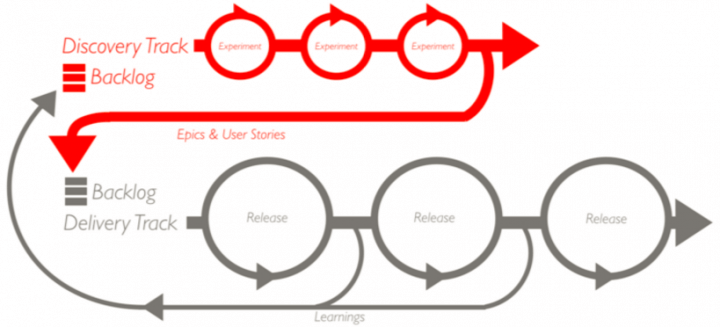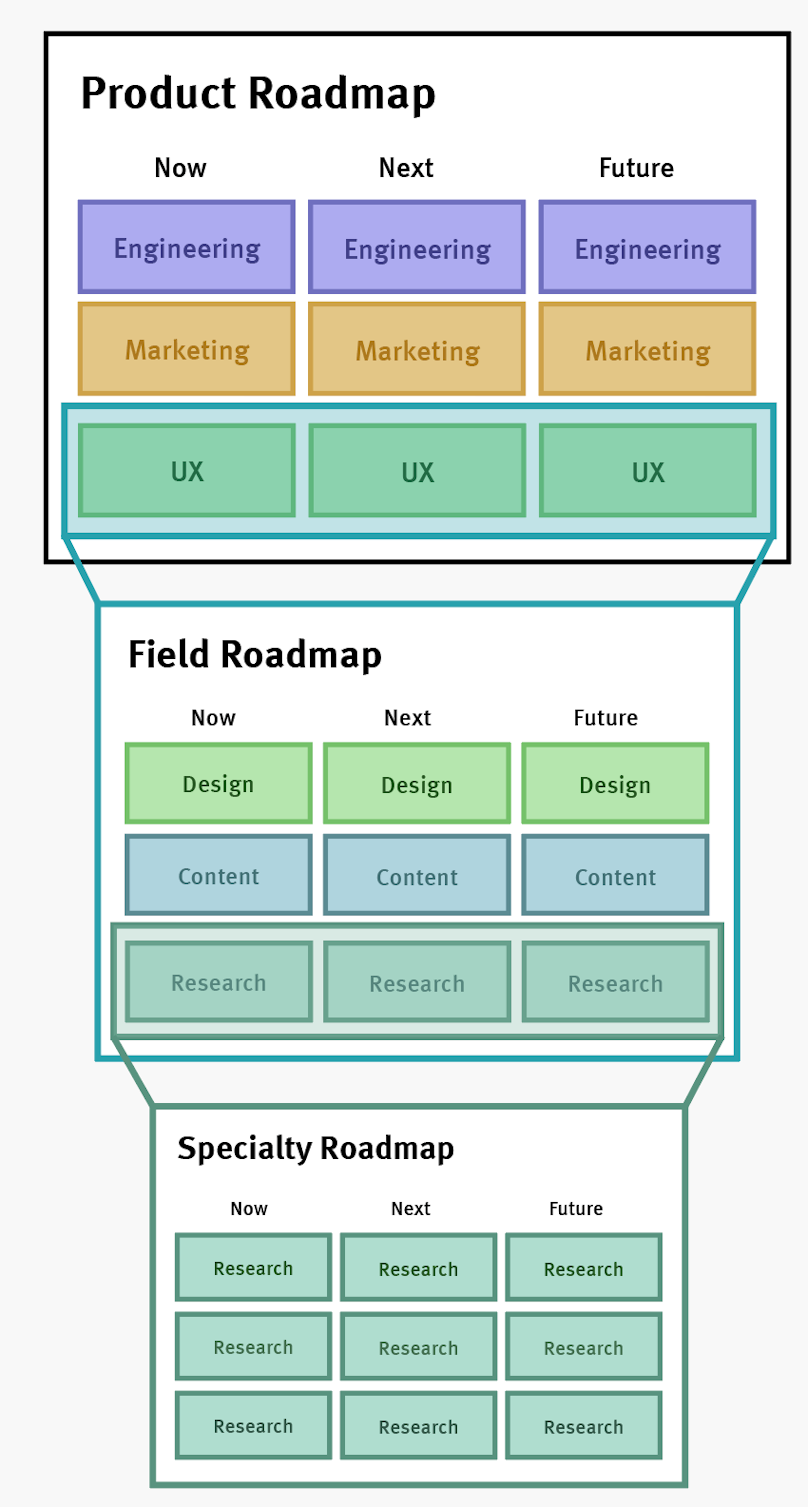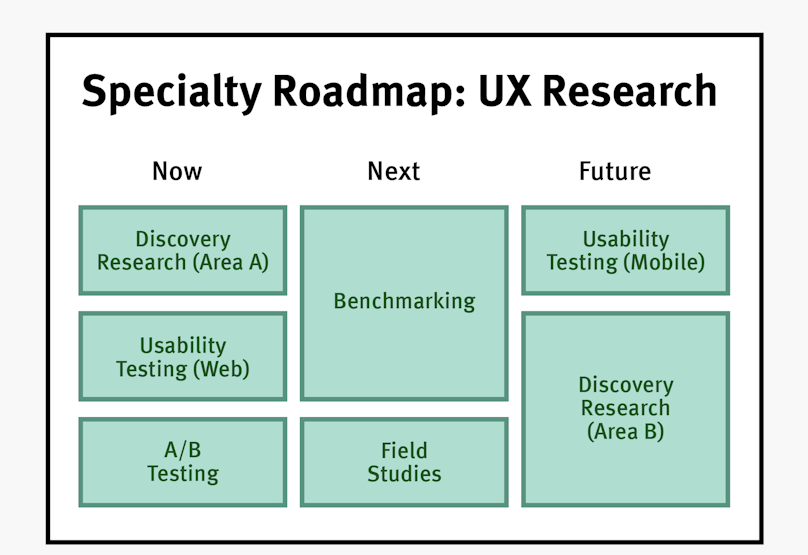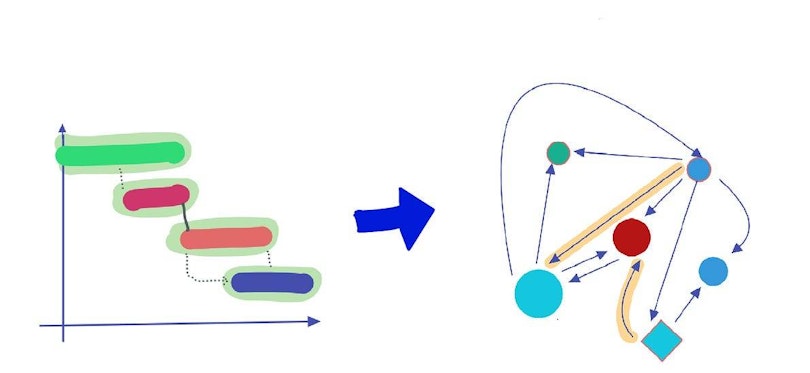How to Create a Successful Product Vision and Roadmap: A Comprehensive Guide to UX-Driven Strategy
Product vision and roadmaps are key tools in product development. A product vision is your ultimate goal you're striving to achieve. And your roadmap is the strategic plan to get there. Together, they form the foundation of successful product development. They are important for creating products that users like and want to use.
In this comprehensive guide, we will explore how product vision and roadmaps intersect with UI/UX design to create outstanding products. We'll also provide practical tips for creating strategies that drive innovation and meet user needs.
So, If you want to improve your product planning and development, keep reading.
Need help with your product vision? Consider joining a product vision workshop.
What are Product Roadmaps?

Product Roadmaps are the most extensive type of roadmap. They:
Involve multiple departments
Require cross-functional collaboration
Get a strategic vision for the entire product
These roadmaps involve teams from:
Product management
UX
Engineering
Marketing
Content strategy
Customer success
What is a UX Roadmap?

A UX roadmap is your strategic guide for future UX initiatives. It outlines:
Problems your team will tackle
Priorities for upcoming work
Progress towards your UX vision
This high-level plan connects your strategy to your team's day-to-day activities. It's not about detailed design processes, but rather about communicating the big picture.
Learn all about product vision and product strategy in Product Vision vs. Product Strategy article.
Why Create a UX Roadmap?
A UX roadmap is a valuable tool for product teams. It helps guide your UX efforts and keeps everyone focused on the same goals. Here are the main reasons to create a UX roadmap:
Your UX roadmap serves multiple purposes:
Aligns your team: It gets everyone on the same page about priorities and goals.
Communicate strategy: It shows the 'why' of your plans to leadership and other teams.
Guides execution: It provides a reference point for decision-making.
Tracks progress: It helps you measure advancement towards your objectives.
Types of Roadmaps

Depending on your needs, you might create one of these roadmap types:
1. Product Roadmaps:
These cover all future problems across departments, including UX, marketing, development, and more.
2. Field Roadmaps:
These focus solely on UX-related issues, such as design, research, and content.
3. Specialty Roadmaps:
These zoom in on a specific area within UX, like user research.
How to Create Your UX Roadmap

When building your roadmap, consider these steps:
1. Define your UX vision:
What's the ideal user experience you're aiming for?
2. Identify key problems:
What stands between you and your vision?
3. Prioritize initiatives:
Which problems, if solved, will have the biggest impact?
4. Set timelines:
When do you aim to tackle each initiative?
5. Communicate clearly:
Make sure your roadmap is easy for all stakeholders to understand.
Remember, your UX roadmap is a living document. It should evolve as you learn more about your users and as your business goals shift.
To get everyone on the same page with your vision, consider attending a product strategy workshop.
What are Product Roadmaps?

Product Roadmaps are the most extensive type of roadmap. They:
Encompass multiple departments
Require cross-functional collaboration
Get a strategic vision for the entire product
These roadmaps involve teams from product management, UX, engineering, marketing, content strategy and customer success.
Benefits of Product Roadmaps
1. Drive Cross-Functional Collaboration of teams
Successful product roadmaps are created jointly by product management and leads from various departments. This process encourages teamwork across different areas of expertise.
2. Create a Shared Vision
They provide a visual representation of efforts in the future that all team members can reference and understand right now.
3. Break Down Department Silos
By including problems from all departments, not just UX, product roadmaps help teams see how their work connects to other areas of the business.
What are the Challenges of Product Roadmaps
1. Require Broad Participation
While it's possible to create a product roadmap in isolation, its effectiveness depends on buy-in from all involved parties. Getting this broad participation can be challenging.
2. Involve Clients and stakeholders
Because product roadmaps are used by everyone, including clients and stakeholders, they often become subject to political considerations. This can include debates over:
Who is the creator of the roadmap
Who has the power to change it
Who is the contributor
What criteria are used for prioritization\
How to Create Effective Product Roadmap
To make the most of your product roadmap:
1. Encourage Collaboration:
Involve all relevant departments from the start.
2. Establish Clear Processes:
Define how the roadmap will be created, updated, and used.
3. Focus on Value:
Prioritize based on what will bring the most value to users and the business.
4. Keep it Flexible:
Remember that your roadmap should adapt as circumstances change.
5. Communicate Regularly:
Use the roadmap as a tool for ongoing discussions about product strategy.
By creating a comprehensive product roadmap, you're setting the stage for better collaboration, clearer communication, and more strategic product development. While it requires effort to create and maintain, a well-crafted product roadmap can significantly improve your team's ability to deliver valuable products.
What are Field Roadmaps: Uniting UX Areas

These roadmaps focus on problems across all UX areas, including:
User research
UX design
Content strategy
Information architecture
Contrary to product roadmaps, these roadmaps can include multiple products areas or or products.
Benefits of Field Roadmaps:
1. Bridge UX Areas
These roadmaps show how different UX teams work together. For example, designers can see the exact research is happening alongside their work.
2. Educate on User-Centered Design
They help demonstrate the UX process to stakeholders who may be less familiar with user-first design approaches.
Challenges of Field Roadmaps:
1. Focus on Process, Not Resources
Field roadmaps give a high-level view but may not provide detailed resource allocation information.
2. Require Coordination
While primarily driven by UX teams, field roadmaps still need input from product managers to align with overall strategy.
What are Specialty Roadmaps: Focusing on One UX Area

Specialty roadmaps narrow the focus to a single UX discipline, such as user research or UX design. They can also include multiple products but only include efforts related to their specific area.
Benefits of Specialty Roadmaps:
1. Show Resource Allocation
These roadmaps clearly display which team members are working on which problems, giving insight into workload distribution.
2. Align Team Members
In organizations where UX areas are spread across different teams, specialty roadmaps help bring awareness and alignment. .
3. Can be Created Easily
Due to their focused nature, specialty roadmaps are often the simplest to develop.
Challenges of Specialty Roadmaps:
1. Limited Audience
Their specific focus means fewer people will find them directly useful.
Choosing the Right Roadmap
When deciding which roadmap to use:
1. Consider Your Audience:
Who needs this information?
2. Think About Scope:
Are you looking at the whole product, all of UX, or just one area?
3. Assess Resources:
How much time can you dedicate to creating and maintaining the roadmap?
4. Evaluate Communication Needs:
What level of detail do you need to share?
By choosing the right type of roadmap, you can effectively communicate your UX strategy, align your team, and guide your work towards creating great user experiences.
How to Create Effective Roadmaps

A well-crafted roadmap guides your team, aligns stakeholders, and helps prioritize work. Let's explore the key elements and processes involved in creating both UX and product roadmaps, along with their benefits and challenges.
Key Elements of a Successful UX Roadmap
To be effective, your UX roadmap should be:
Clear and concise
Actionable
Easy to reference
Focused on outcomes, not just tasks
Creating Your UX Roadmap
When building your roadmap, consider these steps:
1. Define your UX vision:
What's the ideal user experience you're aiming for?
2. Identify key problems:
What stands between you and your vision?
3. Prioritize initiatives:
Which problems, if solved, will have the biggest impact?
4. Set timelines:
When do you aim to tackle each initiative?
5. Communicate clearly:
Make sure your roadmap is easy for all stakeholders to understand.
Remember, your UX roadmap is a living document. It should evolve as you learn more about your users and as your business goals shift.
Aligning Vision and Strategy
Aligning your product vision with your strategic roadmap is essential for successful product development. This alignment ensures that your day-to-day actions and long-term plans work together to achieve your product goals.
Learn how to create product vision in scrum.
How to Align Your Product Vision and Roadmap
To integrate your product vision and roadmap effectively:
1. Use UI/UX design principles to guide your strategy
2. Focus on creating unforgettable user experiences
3. Consider the entire customer journey, from first interaction to final delivery
Creating a Vision-Based Product Roadmap
A vision-based product roadmap is a strategic tool that:
Communicates the purpose behind your product
Allows project leaders to share goals with all the stakeholders and team members
Facilitates collaboration and discussion
Keeps everyone aligned throughout the development process
Key Features of a Vision-Based Roadmap
Evolves with the project
Integrates input from key stakeholders
Considers even small changes during development
Implements strategy
Provides regular updates to external stakeholders
Why Combine Vision and Strategy in Your Roadmap?
A product roadmap that represents both strategy and vision is essential because:
1. It Provides Direction:
Without a clear aim, teams can lose focus and produce meaningless results.
2. It Outlines the Destination:
Your product vision shows where you want to reach and how you'll benefit your company and community.
3. It Maps the Journey:
Your strategy details how you'll execute your plan to achieve your goals.
Creating Your Vision-Based Product Roadmap
To craft an effective vision-based product roadmap:
1. Define Your Vision:
What's the ultimate goal for your product?
2. Develop Your Strategy:
How will you achieve this vision?
3. Incorporate UI/UX Principles:
How can you ensure an excellent user experience throughout?
4. Involve Stakeholders:
Get input from clients, team members, and other key players.
5. Stay Flexible:
Be ready to adapt your roadmap as circumstances change.
6. Communicate Regularly:
Keep all stakeholders updated on progress and changes.
By aligning your product vision and roadmap with strong UI/UX design principles, you're setting your product up for success. This approach ensures that you're not just building a product, but creating an experience that resonates with your users and achieves your business goals.
Key Aspects of Product Strategy
Your product strategy is the bridge between your product vision and its realization. It should include:
1. Customer and market and needs
2. Main product characteristics
3. Differentiators from competitors
A well-thought-out strategy ensures a well defined path to successful product development.
If you need help with your design strategy, see our guide on the best design strategy firms
Best Practices for Your UX Roadmap

To ensure success with your UX roadmap:
1. Focus on High-Level Initiatives:
Connect these to your strategic long-term goals
2. Incorporate User Research:
Use insights to identify problems and prioritize work
3. Review Regularly:
Be prepared to adjust as plans change
4. Involve Stakeholders:
Ensure alignment throughout the process
Wrapping Up
To sum it up,creating a design-oriented product roadmap is an ongoing process that requires:
1. Clear understanding of your target audience
2. Alignment between UI/UX goals and overall product strategy
3. Detailed breakdown of tasks and responsibilities
4. Regular review and adjustment
5. Stakeholder involvement and buy-in
By following these steps and best practices, you can create a roadmap that not only guides your product development but also ensures a user-centered approach. This strategy helps you build products that meet user needs while achieving your business objectives.
Remember, tools like Maze can help you gather quick user insights to inform your roadmap decisions. By integrating user feedback throughout your process, you can create products that truly resonate with your target audience.
FAQs
What role does a roadmap play in product design?
A product roadmap serves as a shared reference point that outlines the vision, direction, and progress of a product over time. It's a tool that keeps everyone aligned on the product's journey.
What's the typical timeframe for a product roadmap?
Based on a survey of over 500 product professionals across various industries, the most common roadmap timeframe is one year. The second most popular is 4 to 6 months, followed by 2 to 3 months ahead.
Is a product roadmap necessary?
Product roadmaps are crucial because they provide a clear, concise overview of a product's development journey. They're used to communicate with various stakeholders, including investors, customers, and team members. A well-crafted roadmap ensures everyone is aligned on the product's direction.
Which should come first: strategy or roadmap?
Think of strategy as the blueprint for your product's foundation and framing. The roadmap then builds upon this blueprint, providing a detailed plan for constructing a fully-functioning product. In other words, strategy typically precedes and informs the roadmap.
How would you define a product roadmap?
A product roadmap is a high-level visual summary that charts out the vision and direction of your product offering over time. It communicates the 'why' and 'what' behind your product development. It's both a strategic guide and a plan for executing your product strategy.





